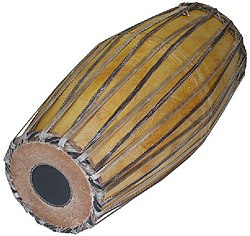Mridang
 |
|
| Percussion instrument | |
|---|---|
| Developed | First mentioned as a tannumai in the Naṟṟiṇai of the Ettuthokai of the Eighteen Major Anthology Series of Classical Tamil literature. |
| Related instruments | |
| Musicians | |
|
|
| More articles | |
| Carnatic music | |
The Mridangam (Sanskrit: :मृदंग Kannada: :ಮೃದಂಗ Tamil: :மிருதங்கம் Malayalam: :മൃദംഗം) is a percussion instrument from India of ancient origin. It is the primary rhythmic accompaniment in a Carnatic music ensemble, and in Dhrupad, where it is known as Pakhawaj.
During a percussion ensemble, the mridangam is often accompanied by the ghatam, kanjira, and morsing.
In Tamil culture, it is called a tannumai.The earliest mention of the mridangam in Tamil literature is found perhaps in the Sangam literature where the instrument is known as 'tannumai'. The word "Mridangam" is Sandhi or union of the two Sanskrit words mŗt (clay or earth) and anga (limb), as early Mridangam were made of hardened clay.
In ancient Hindu sculpture, painting, and mythology, the mridangam is often depicted as the instrument of choice for a number of deities including Ganesha (the remover of obstacles) and Nandi, who is the vehicle and follower of Shiva. Nandi is said to have played the mridangam during Shiva's primordial tandava dance, causing a divine rhythm to resound across the heavens. The mridangam is thus also known as "Deva Vaadyam," or "Divine Instrument".
Over the years, the mridangam evolved to be made of different kinds of wood due to its increased durability, and today, its body is constructed from wood of the jackfruit tree. It is widely believed that the tabla, the mridangam's Hindustani musical counterpart, was first constructed by splitting a mridangam in half. With the development of the mridangam came the tala (rhythm) system.
...
Wikipedia
